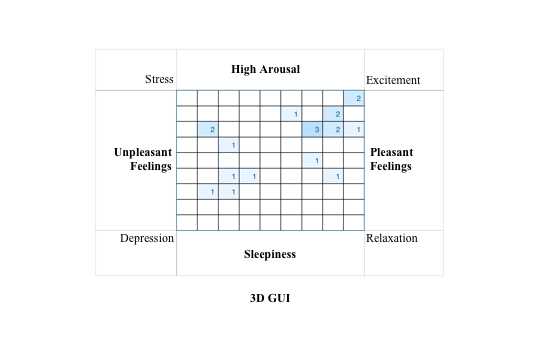Section #3
Conclusion and Result

meCUE 2.0 results.
Intuitive design, high usability score
It is seen that the product designed in accordance with the interaction design principles positively affects the usability score. Thanks to the consistent interaction and visual design of navigation and selection in the AvatarEditor (2D), the participants quickly completed the task. The observation insights were verified by the highness of usability and overall assessment scores obtained on the meCUE 2.0 scale (module I).

Affect Grid-scale results.
High usability score, high positive feelings
According to the results obtained with the meCUE 2.0 scale, a directly proportional relationship was found between the usability scores of the assessed applications and the positive emotion scores. The positive emotions score of Avatar Editor (2D), which has a high usability score, is higher than Thread Studio (3D).
According to the results of the Affect Grid-scale of Thread Studio (3D), a total of 7 participants marked the region covering the areas of stress, unpleasant feeling, and depression (The reason explained in the further paragraphs). In the scale results of Avatar Editor (2D), it was seen that only 2 participants marked this region. These data also confirmed that there is a directly proportional relationship between usability scores obtained with the meCUE 2.0 scale (module II) and positive emotion scores (Affect Grid-scale).
The effect of 2D or 3D GUI on usability score
The impact of the graphical user interface design, 2D or 3D, on the usability score has not been fully confirmed. However, it was found that the usability score of the 3D GUI was negatively affected by the poor design. Since the three-dimensional object interaction includes complex varieties of interactions and the Thread Studio (3D) had some design mistakes that was discovered during the study. That's why the hypothesis should be examined again. It should be repeated through testing with another 3D application, which includes no interaction design mistakes. The details are discussed in the further paragraph.
H1: The usability score of a VR environment that consists of a 3D interface design is higher than a 2D interface design.

Thread Studio, flat 2D GUI.

Thread Studio, 3D object interaction.
The screenshots are taken in the Oculus Rift, Thread Studio (3D) app.
Importance of the interaction and object design in 3D GUIs
The design mistake, which can be seen in the picture above (right), affected the usability score of the Thread Studio (3D). The issue was discovered during usability testing. The problem was the color card on the menu was designed as a flat object (2D GUI), although the user was expected to interact as a 3D object with it. So, the participants touched the 2D color card as a flat touch screen and expected it to activate or open. However, they were not able to get feedback on this touch. They had to think for a while, and after several attempts, they tried to grab the card in their hands, inspired by the task of exercising. In order for the interface design to be consistent, the color card should be designed in 3D like other objects in the environment. However, the design and software of Thread Studio (3D) were not made by the author. Due to time constraints, a selection was made among the existing applications. In the absence of software development and design constraints, these design errors can be corrected (by designing the color card as a 3D object), and a similar study can be repeated. So, hypothesis one can be examined again.

The participant liking and preference results.
H2: The users prefer to accomplish the given task in the VR environment that consists of a 3D interface design against a 2D interface design.
Suggestions
3D object design, interaction design and XR
It is suggested to consider the basic principles of interaction design along with the GUI design principles for the 3D GUI design process. Don Norman's book, Design of Everyday Things, is also thought to help the three-dimensional object and 3D GUI design process. In addition, it is suggested to use Murtza, R. et al. (2017)'s Virtual Reality Heuristics as a checklist based on Heuristic Evaluation, one of the UX research methods.
The Scales that can be applied in VR
Within the scope of this research, observational data and meCUE scale gave consistent results with each other showed that meCUE scale can be used in VR environments. However, it was determined that the scale was not sufficient alone, and observation and Think-Aloud techniques should definitely be used.

















